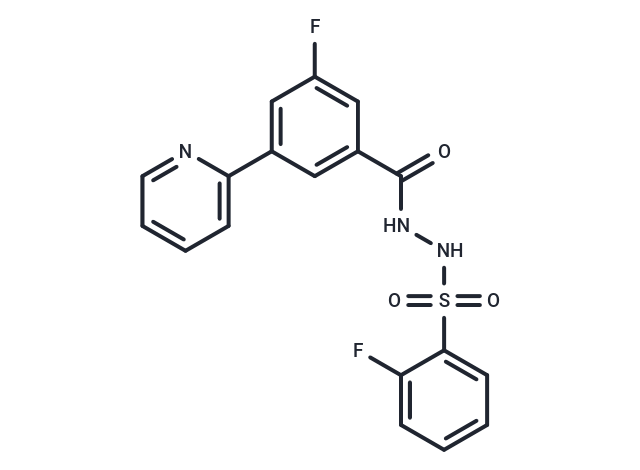Shopping Cart
- Remove All
 Your shopping cart is currently empty
Your shopping cart is currently empty

WM-1119 is a highly potent, selective KAT6A/B inhibitor

| Pack Size | Price | Availability | Quantity |
|---|---|---|---|
| 5 mg | $47 | In Stock | |
| 10 mg | $64 | In Stock | |
| 25 mg | $106 | In Stock | |
| 50 mg | $156 | In Stock | |
| 100 mg | $231 | In Stock | |
| 1 mL x 10 mM (in DMSO) | $52 | In Stock |
| Description | WM-1119 is a highly potent, selective KAT6A/B inhibitor |
| Targets&IC50 | KAT6A:2 nM(KD), KAT6A:0.25 μM, KAT7:0.5 μM(KD), KAT5:2.2 μM(KD) |
| In vitro | WM-1119 induces cell cycle exit and cellular senescence without causing DNA damage. It is 1,100-fold and 250-fold more active against KAT6A than against KAT5 or KAT7, respectively, demonstrating greater specificity for KAT6A than WM-8014. Testing WM-1119 at 1 μM and 10 μM against a pharmacological panel of 159 diverse biological targets reveals no affinity. Treatment of MEFs with WM-1119 results in cell cycle arrest in G1 and produces a senescence phenotype similar to WM-8014. Notably, the activity of WM-1119 in cell-based assays is an order of magnitude greater than WM-8014 and induces cell cycle arrest at 1 μM. WM-8014 and WM-1119 both inhibit the proliferation of EMRK1184 lymphoma cells in vitro, with WM-1119 (IC50=0.25 μM) being ninefold more active than WM-8014 (IC50=2.3 μM), as expected based on reduced protein binding. |
| In vivo | Male C57BL/6-albino (B6(Cg)-Tyrc-2J/J) mice are injected intravenously with 100,000 EMRK1184 cells transfected with a luciferase-expression construct. Lymphoma growth is monitored. Three days after the lymphomacell transplant, all mice show luciferase activity, which indicate the expansion of lymphoma cells. Mice are then divided randomly into WM-1119-treatment with different conentrations (1, 2.5, 5, 10 μM) and vehicle-control groups. Because WM-1119 is rapidly cleared after intraperitoneal injection, with the plasma concentration decreasing to below 1 μM after 4-6 h cohorts of mice are injected every 8 h (three times per day, two cohorts of three mice per treatment group) or every 6 h (four times per day, two cohorts of three and six mice per treatment group).By day 14, the cohorts that are treated four times per day with WM-1119 have arrested tumour growth, with the exception of one mouse that does not respond. Spleen weights in the WM-1119-treatment group (treated four times per day) are substantially lower than spleen weights in the vehicle-treated group, and not significantly different from those of tumour-free eight-weekold mice. Treatment with WM-1119 three times per day leads to a significant reduction in tumour burden and spleen weight, but is not as effective as treatment four times per day. WM-1119 is well-tolerated; mice show no generalized ill effects and weight loss is not observed. WM-1119 treatment has no effect on haematocrit, erythrocytes or platelet numbers, but there is overall leukopenia. The proportion and overall number of tumour cells is substantially reduced by WM-1119 treatment (four times per day). |
| Animal Research | Male C57BL/6-albino (B6(Cg)-Tyrc-2J/J) mice are injected intravenously with 100,000 EMRK1184 cells transfected with a luciferase-expression construct. Lymphoma growth is monitored. Three days after the lymphomacell transplant, all mice show luciferase activity, which indicate the expansion of lymphoma cells. Mice are then divided randomly into WM-1119-treatment with different conentrations (1, 2.5, 5, 10 μM) and vehicle-control groups. Because WM-1119 is rapidly cleared after intraperitoneal injection, with the plasma concentration decreasing to below 1 μM after 4-6 h cohorts of mice are injected every 8 h (three times per day, two cohorts of three mice per treatment group) or every 6 h (four times per day, two cohorts of three and six mice per treatment group).By day 14, the cohorts that are treated four times per day with WM-1119 have arrested tumour growth, with the exception of one mouse that does not respond. Spleen weights in the WM-1119-treatment group (treated four times per day) are substantially lower than spleen weights in the vehicle-treated group, and not significantly different from those of tumour-free eight-weekold mice. Treatment with WM-1119 three times per day leads to a significant reduction in tumour burden and spleen weight, but is not as effective as treatment four times per day. WM-1119 is well-tolerated; mice show no generalized ill effects and weight loss is not observed. WM-1119 treatment has no effect on haematocrit, erythrocytes or platelet numbers, but there is overall leukopenia. The proportion and overall number of tumour cells is substantially reduced by WM-1119 treatment (four times per day). |
| Alias | WM1119 |
| Molecular Weight | 389.38 |
| Formula | C18H13F2N3O3S |
| Cas No. | 2055397-28-7 |
| Smiles | Fc1cc(cc(c1)-c1ccccn1)C(=O)NNS(=O)(=O)c1ccccc1F |
| Relative Density. | 1.414 g/cm3 (Predicted) |
| Storage | Powder: -20°C for 3 years | In solvent: -80°C for 1 year | Shipping with blue ice. | |||||||||||||||||||||||||||||||||||
| Solubility Information | DMSO: 150 mg/mL (385.23 mM), Sonication is recommended. | |||||||||||||||||||||||||||||||||||
Solution Preparation Table | ||||||||||||||||||||||||||||||||||||
DMSO
| ||||||||||||||||||||||||||||||||||||

Copyright © 2015-2025 TargetMol Chemicals Inc. All Rights Reserved.